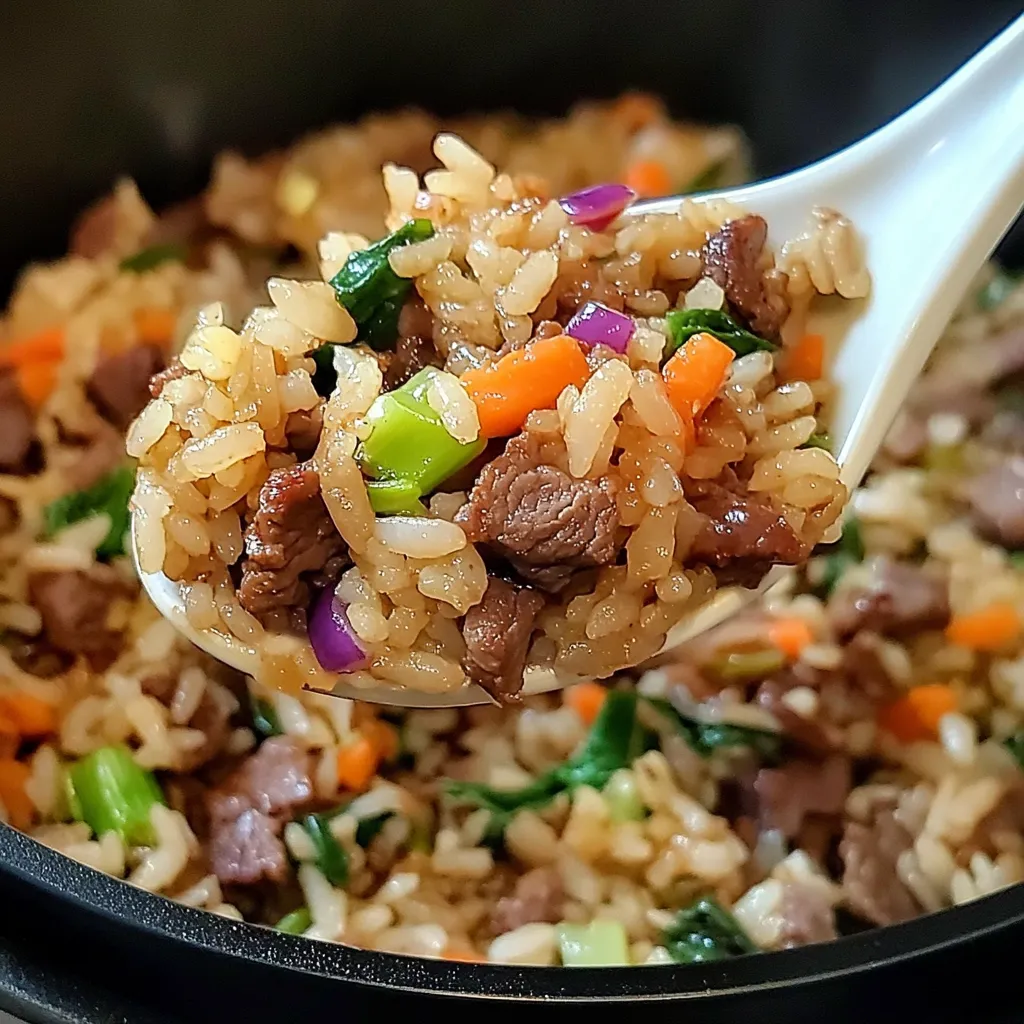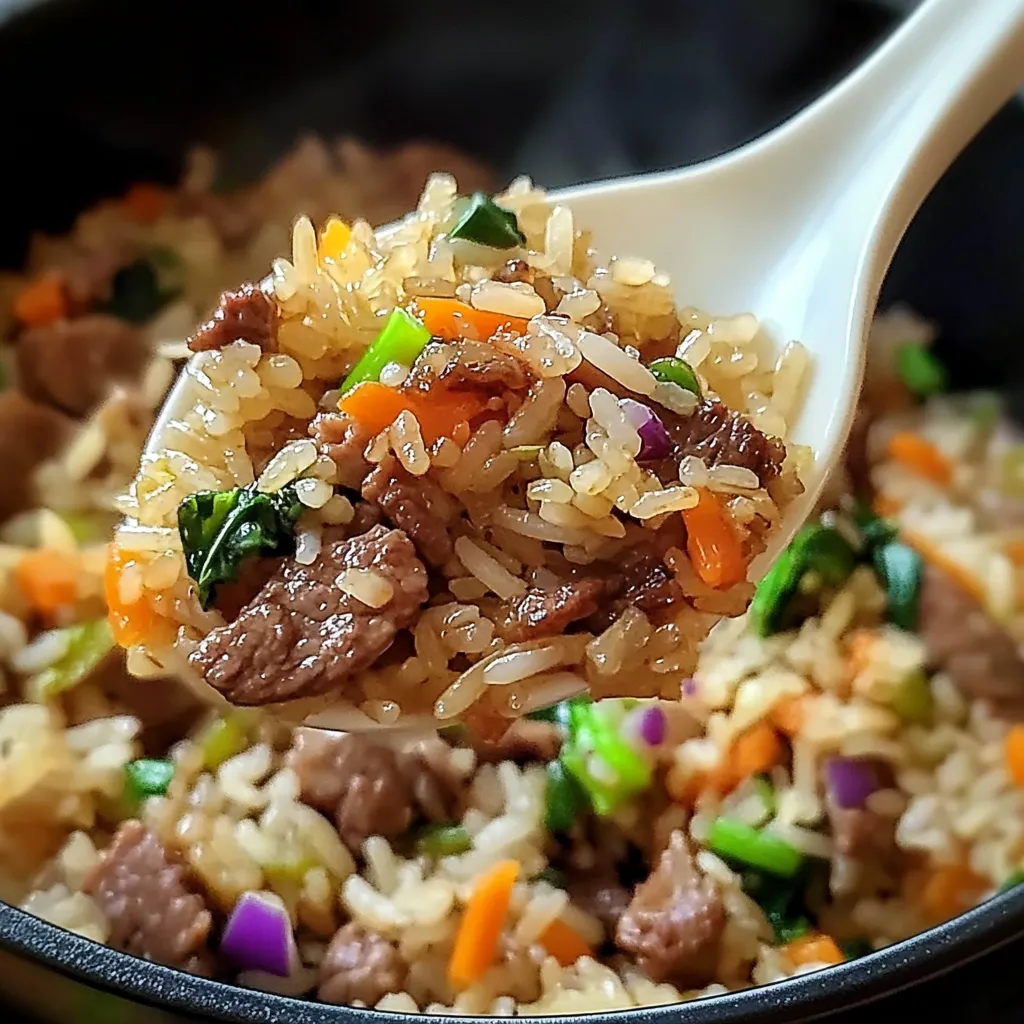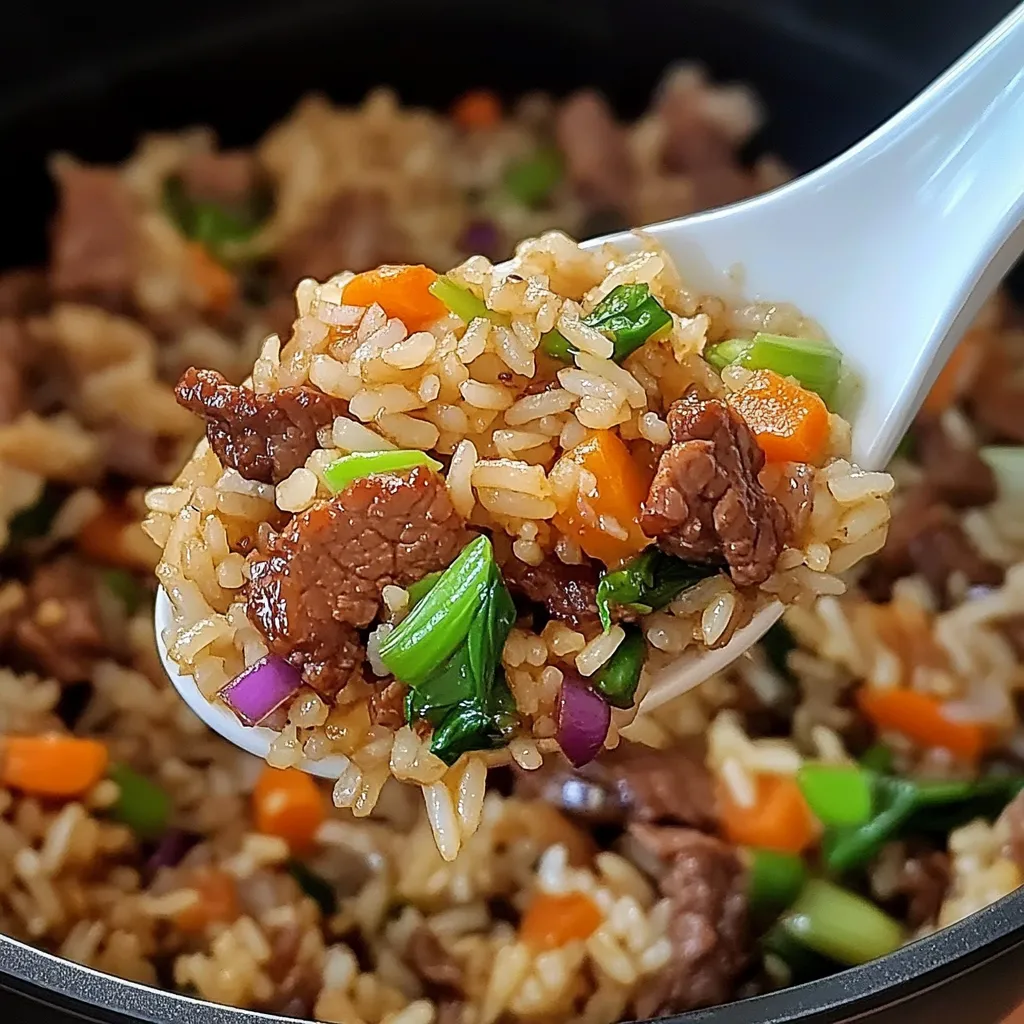 Save
Save
Caramelized onions meld with savory beef and perfectly toasted rice grains in this exceptional interpretation of a beloved global classic. This Savory Onion Beef Fried Rice transforms humble ingredients into an extraordinary dining experience through the careful development of complementary flavors and textures. Each spoonful delivers the perfect balance of sweet aromatic onions, umami-rich beef, and toasted rice—creating a dish that feels simultaneously nostalgic and revelatory, comfortable yet sophisticated.
I discovered this versatile combination during a particularly resourceful kitchen moment when faced with leftover rice and ground beef that needed immediate attention. The first time I served this impromptu creation, my typically distracted family actually put down their devices to ask what made it taste so different from ordinary fried rice. My teenage son, notorious for his limited palate, requested seconds and asked if we could have it again that week. What began as refrigerator improvisation has evolved into our most-requested weeknight meal, proving that sometimes necessity truly is the mother of delicious invention.
Flavor Foundations
- Ground beef: Lean varieties (85/15) offer clean flavor; slightly higher fat content creates richer results
- Onions: Sweet yellow varieties caramelize beautifully; red onions provide beautiful color contrast
- Day-old rice: Long-grain varieties maintain structural integrity; medium-grain offers pleasing chewiness
- Soy sauce: Naturally brewed delivers superior flavor complexity; low-sodium allows better seasoning control
- Garlic: Fresh cloves provide aromatic depth; minced or pressed creates proper distribution
- Ginger: Fresh root delivers bright, zingy notes; microplane-grated ensures no fibrous bits
- Sesame oil: Toasted varieties impart essential nutty aroma; use sparingly to avoid overwhelming
- Green onions: Both white and green parts serve different purposes; slice on dramatic bias for presentation
- Black pepper: Freshly ground significantly outperforms pre-ground for aromatic punch
- Red chili flakes: Provides customizable heat level; Korean gochugaru offers sophisticated alternative
Culinary Creation
- Rice Preparation
- Begin with properly cooled day-old rice, ideally refrigerated uncovered overnight to allow excess moisture to evaporate. This critical step ensures each grain remains distinct during cooking rather than clumping together. If you must use freshly made rice, spread it on a baking sheet in a thin layer and refrigerate uncovered for at least one hour before using. Just before cooking, break apart any clumps with your fingers, creating individual grains that will toast properly in the pan rather than steam and become gummy.
- Protein Development
- Heat a well-seasoned wok or large skillet over medium-high heat until a drop of water instantly evaporates on contact. Add a small amount of neutral oil with high smoke point, then immediately add ground beef, breaking it into small, even crumbles with a wooden spoon as it cooks. Allow the meat to develop caramelization by resisting the urge to stir constantly—this browning creates essential flavor through Maillard reactions. Once properly browned, add minced garlic and grated ginger, stirring constantly for thirty seconds until fragrant but not burned, which would create bitterness.
- Onion Transformation
- Push the seasoned beef to one side of your cooking vessel, then add thinly sliced onions to the empty space. Allow them to cook undisturbed for one minute to initiate browning before stirring occasionally. The onions will gradually transform from sharp and pungent to sweet and aromatic as their natural sugars caramelize. This process should take approximately 5-7 minutes—rushing this step sacrifices depth of flavor. The onions should reach a golden brown color before proceeding, indicating they've released their essential sweetness that balances the savory elements in the dish.
- Rice Integration
- Increase heat to high, then add the prepared rice to the pan, drizzling with a small amount of sesame oil. Use a flat-edged spatula to press the rice against the hot surface, allowing it to toast briefly before tossing. This pressing-and-tossing technique creates the perfect combination of softened and crispy rice grains that define exceptional fried rice. Continue this process for approximately 3 minutes until the rice develops a subtle toasted aroma and takes on a slightly golden hue in spots, indicating proper development of flavor and texture.
- Harmonious Finishing
- Season the mixture with soy sauce, black pepper, and optional chili flakes, tossing thoroughly to distribute. Add any additional vegetables like carrots or peas at this stage, cooking just long enough to heat through while maintaining their fresh texture and color. Fold in thinly sliced green onion whites, reserving the green portions for garnish. Allow everything to cook together for one final minute, giving the flavors opportunity to meld while the soy sauce caramelizes slightly on the hot rice grains. Taste and adjust seasoning before transferring to a serving dish and garnishing with the reserved green onion tops.
 Save
Save
My grandmother always insisted that 'true kitchen wisdom comes from making something extraordinary from what others consider ordinary,' and this dish embodies her philosophy perfectly. The first time I served it to dinner guests, a friend who had lived in Asia for several years took one bite and said, 'This tastes like the fried rice I remember from street stalls—how did you know the secret?' Sometimes the most profound culinary achievements come not from exotic ingredients but from understanding how to maximize the potential of everyday elements through proper technique and respect for each component.
Creative Variations
Transform this versatile dish to accommodate various preferences while maintaining its essential character. Substitute ground chicken, turkey, or plant-based crumbles for the beef to create lighter or vegetarian versions. Create a spicier profile by incorporating diced fresh chilis or doubling the chili flakes. Introduce complexity with a tablespoon of oyster sauce or fish sauce alongside the soy sauce. Explore vegetable additions like diced bell peppers, snow peas, or bean sprouts for nutritional diversity and textural contrast. For special occasions, consider topping with a fried egg whose runny yolk creates a luxurious sauce when broken, or garnishing with crushed peanuts for added crunch.
Serving Suggestions
This versatile dish welcomes thoughtful accompaniments that complement its satisfying nature. Serve with a simple cucumber salad dressed with rice vinegar for refreshing contrast to the rich flavors. Offer chili oil or sambal oelek tableside for heat enthusiasts to customize their portions. Consider small bowls of kimchi or pickled vegetables for acidic brightness that cuts through the dish's richness. For informal gatherings, present family-style in a large serving bowl to maintain warmth throughout the meal. For more elegant presentation, pack the rice firmly into a small bowl before inverting onto individual plates, creating a perfect dome shape garnished with precisely placed green onions.
Practical Preservation
Store leftovers properly to maintain quality for several days of continued enjoyment. Allow the dish to cool completely before transferring to airtight containers, which prevents condensation that would make the rice soggy. Refrigerate for up to three days, knowing the flavors often deepen overnight as the ingredients continue to meld. Reheat in a hot skillet rather than microwave when possible, adding a small sprinkle of water and a drizzle of oil to revive the rice's texture. For best results, add fresh garnishes after reheating to maintain color and textural contrast. This dish does not freeze particularly well due to textural changes in the rice, so enjoy within the recommended refrigeration timeframe.
 Save
Save
The first time I prepared this Savory Onion Beef Fried Rice, I was simply seeking an efficient way to transform leftovers into something more interesting than their original forms. What I discovered was a dish that creates more satisfaction with less effort than many of my more complex recipes. Each time I make it, I'm reminded that cooking at its best is about understanding transformation—how heat and technique can elevate humble ingredients, how proper sequencing builds layers of flavor, and how respecting each component's nature creates something harmonious and deeply satisfying from the simplest pantry staples.
Common Questions About Cooking
- → Why do I need to use day-old rice?
- Day-old rice that's been refrigerated has had time to dry out, making the grains firmer and less sticky. This prevents the rice from clumping together when stir-fried, resulting in a better texture with distinct, separate grains. If you don't have leftover rice, you can cook fresh rice, spread it on a baking sheet, and refrigerate it for at least 1 hour before using.
- → Can I use other types of meat?
- Yes, this recipe is very adaptable! You can substitute the ground beef with ground chicken, turkey, or pork. For a non-ground meat option, thinly sliced beef, chicken, or pork work well too. Just adjust the cooking time accordingly to ensure the meat is fully cooked. For a vegetarian version, try using crumbled tofu or mushrooms instead.
- → What vegetables can I add to this fried rice?
- This recipe is great for using up leftover vegetables. Besides the carrots and peas mentioned, you can add bell peppers, broccoli florets, snap peas, corn, or bean sprouts. Frozen mixed vegetables work perfectly too. For best results, make sure any vegetables you add are cut into small, uniform pieces so they cook quickly and evenly.
- → How can I make this recipe gluten-free?
- To make this recipe gluten-free, simply substitute regular soy sauce with tamari or certified gluten-free soy sauce. All other ingredients in the basic recipe are naturally gluten-free, but always check labels if you're adding other condiments or pre-packaged items. With this simple swap, you can enjoy this delicious fried rice without worry.
- → Can I make this dish ahead of time?
- Yes, this fried rice reheats well and is great for meal prep. Store it in an airtight container in the refrigerator for up to 3-4 days. When reheating, add a splash of water to prevent the rice from drying out, and stir occasionally to ensure even heating. You can reheat in a microwave or in a skillet over medium heat.
- → What's the best way to caramelize onions for this recipe?
- For perfectly caramelized onions, slice or dice them evenly and cook them over medium heat with a bit of oil. Be patient - good caramelization takes time, usually 10-15 minutes. Stir occasionally but not constantly to allow browning. If they start to burn, lower the heat. For extra flavor, add a pinch of sugar to help the caramelization process or a splash of soy sauce for deeper color and umami flavor.
